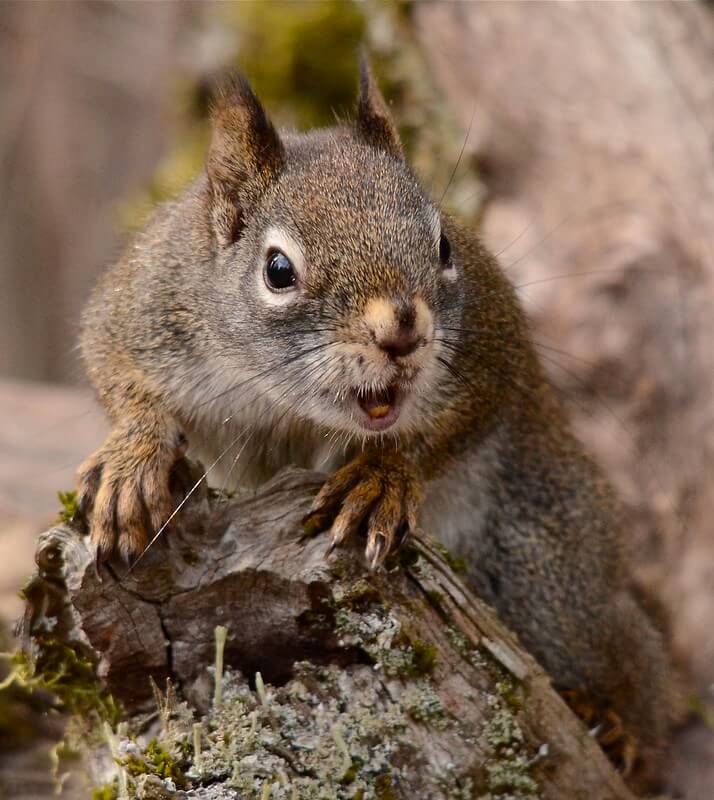Keeper of the Woods
By Kate Wasem
Broadcast 10.26 & 10.29.2022

A pine squirrel scolds loudly. Photo by Eugene Beckes, CC-by-NC-SA 2.0.
Listen:
An early autumn morning in the woods during hunting season begins quietly. My husband and I take care to place our steps softly and move with intention. We whisper or use hand signals to communicate. In those moments just before dawn, as I’m hunkered down behind a log taking stealthy sips from my thermos, the whole world seems to be asleep, dreaming pleasantly.
Then, it happens. A pine squirrel wakes up. First one, then another, then three hundred, then five thousand, and before long the evergreen canopy is buzzing with their banter. From that moment forward, my pre-dawn slyness is a distant memory. There is no unwatched, uncriticized movement in these woods anymore. Any step I take is met with angry feedback from above.
Who are these tiny, chattering sentinels, announcing my presence to every ungulate in the Bitterroot Valley and beyond?
Pine squirrels are one of only two native tree squirrels in Montana – the other is the northern flying squirrel – and they’re the smallest of their kind in North America, less than 30 percent the size of the eastern gray squirrel, and only one-fourth the size of a fox squirrel. But don’t tell them that. Their big, aggressive personalities belie their small stature. They will arduously defend their nook of the woods from gigantic intruders (such as myself), without batting an eye. In fact, I’ve looked them in the eye – they never blink.
Try it some time. Walk towards the cacophony and confront your interrogator. Look past the accusing stares, the stamping feet, and the shaking tail. Notice the brownish-red fur on its back, earning it the common name North American red squirrel. Not to be confused with the European red squirrel, which is much larger and has pointy tufts of fur on its ears, and often shows up in children’s books written by British authors. Our native variety of red squirrel is found mostly in the upper latitudes of the United States, extending its range north into Canada and Alaska, and south into New Mexico. Wherever a stand of cool conifers with interlocking canopies is found, there be pine squirrels.
Those boreal evergreen environments offer two of the pine squirrels’ favorite foods: conifer seeds and fungi. The seeds they cache in piles called middens, and the mushrooms they hang from a branch to dry before storing. This instinct to stockpile is reflected in the first part of its scientific name – Tamiasciurus – which roughly translates from the Greek to mean “hoarder squirrel.” Although this behavior can sometimes seem greedy, pine squirrels have a habit of forgetting about some of their scattered seed stashes. Overlooked middens turn into little conifer nurseries, and the squirrels thus play their part in the continuity of their ecosystem – however self-interested their actions may be.
Back in my stand of ponderosas in the Sapphire mountains, my rifle taking a long nap at my side, I watch the commotion above my head. Pine squirrels race along branches, yammering at one another, but one has zeroed in on my presence and clucks disapprovingly. This is, after all, the time of year when seed stockpiling is at its peak, and competition for territory is fierce. I may be seen as a predator, or as a potential challenger to its winter food supply. However it may interpret my presence below, one thing is clear: the pine squirrel – or red squirrel – or just plain ol’ chatterbox – is the keeper of the woods, protector of pinecones, guardian of the treetops, and all-season lookout. I can’t help but be charmed by its fury and steadfastness. I will soon depart these woods, but the pine squirrel remains – and perhaps rejoices, having secured its realm once again.
Every week since 1991, Field Notes has inquired about Montana’s natural history. Field Notes are written by naturalists, students, and listeners about the puzzle-tree bark, eagle talons, woolly aphids, and giant puffballs of Western, Central and Southwestern Montana and aired weekly on Montana Public Radio.
Click here to read and listen to more Field Notes. Field Notes is available as a podcast! Subscribe on iTunes or wherever you listen to podcasts.
Interested in writing a Field Note? Contact Allison De Jong, Field Notes editor, at adejong [at] montananaturalist [dot] org or 406.327.0405.
Want to learn more about our programs as well as fun natural history facts and seasonal phenology? Sign up for our e-newsletter! You can also become a member and get discounts on our programs as well as free reciprocal admission to 300+ science centers in North America!












